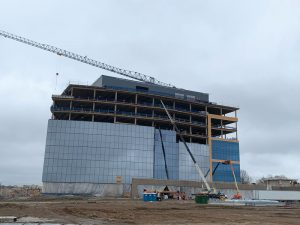Although the ASTM A913 specification has been around for over 20 years, there has recently been a renewed interest in using ASTM A913 Quenched and Self-Tempered Structural Steel Shapes. Weight and cost savings are obtained by using the higher strengths of A913 versus conventional A992. For building structures, the most significant advantage of this specification is for column and truss sections where the designer can realize a 10 to 20% weight saving by using the higher strength available in A913 Grade 65 as compared to the standard 50 ksi yield strength of A992. This increased strength has allowed steel structure design to compete successfully against other materials. Some recent projects which benefited from the use of A913 include the Allegiant Stadium in Las Vegas, Globe Life Field in Arlington, TX, and the Hudson 66 Boulevard project, “The Spiral,” in New York City.
These structural shapes are also applicable to the bridge market. Recently, the A913 specification has been added to the A709 Standard Specification for Structural Steel for Bridges as Grades QST 50, QST 50S, QST 65, and QST 70. To date, Buchanan County in Iowa has completed a single span bridge made with beams produced to the A913 Grade 65/A709 QST 65 specification. Preliminary fatigue tests at Edison Welding Institute in Columbus, OH, of A913 versus A992, indicated higher endurance stress when utilizing A913. More fatigue property research needs to be completed to make this finding conclusive; however, the initial data is promising. Continued use of A913 in bridge applications is an opportunity for further growth in utilizing higher strength structural shapes to lower the weight and cost of the bridge.
ASTM A913 is available in several W-sections, with W14x90 to W14x730 being the most commonly ordered sections in Grade 65, in the author’s experience. Lighter weights are not available in A913 due to the thermal energy requirement of the process. Specifically, the W-section has to have enough thermal mass to temper the section after quenching. On light sections, there is not enough remaining thermal energy to rebound the surface of the section to the 1100-1300F self-tempering temperature after being processed through the quenching equipment. Currently, A913 W-sections are available from more than one producer and are available domestically through most fabricators. Designers are encouraged to reach out to their local steel service centers and fabricators to determine what sections are readily available in A913 and rolling schedule/delivery time frames. Current pricing compares favorably to other structural steel grades and, typically, the weight savings more than offset any price differential.
One of the additional benefits of utilizing A913 wide flange sections is that the specifications require mandatory Charpy impact tests at the flange locations. This requirement, 40 ft-lbf at 70°F, provides a level of confidence to the design engineer of the resistance to brittle fracture of the beam. Typically, when using other material specifications, Charpy impact tests at the flange locations are only available from the producer for an additional cost. Additionally, when using A913 wide flange sections, the Supplementary Specification S30 in ASTM A6 can be utilized to get Charpy impact testing at the alternate core location when the flange thickness equals or exceeds 1.5 inches. The design engineer should specify this requirement in the design documents.
When contrasting the chemistry requirements of A913 to A992, it is apparent that the carbon maximum of A913 is roughly half of A992. Metallurgical benefits include enhanced brittle fracture resistance, increased ductility, and improved weldability. Looking specifically at the Carbon Equivalent (C.E.) maximums, A913 has a comparable C.E. level to A992 with higher tensile properties.
A913 phosphorus, sulfur, and copper maximums are also lower than A992, thus providing a higher quality structural steel section. The lower the copper, sulfur, and phosphorus, the better the steel’s mechanical properties. Some copper is beneficial for corrosion resistance, but too high a level may create a surface defect. Phosphorous and sulfur make steel brittle; that is why ASTM specifies a maximum content of these elements. In summary, for equivalent chemistry, higher strength steel can be utilized with the same degree of weldability.
The weldability of A913 has been thoroughly tested in fabrication practice and has been in the prequalified chapter of the American Welding Society D1.1 Structural Welding Code for some time. Within D1.1., A913 is qualified to be welded to other structural grades such as A992 and A572, and Welding Procedure Specifications (WPS) exist for welding the dissimilar steel strengths. One of the unique requirements of the ASTM A913 specification is for the producer to provide the purchaser (service center or fabricator) with weldability data from tests on the previous production (after contract, upon request). This weldability data consists of a complete joint penetration groove weld according to AWS D1.1 and an oblique Y groove test, according to AWS B4.0. This is done primarily to verify the preheat temperature requirements of the WPS and to give the fabricator/customer guidance on the development of their own WPS.
The potential of higher strengths of A913 is continually being researched. A Grade 80 version of A913 was recently approved by ASTM and is currently available to the market. The use of higher strength structural steel that is produced in the as-rolled condition, versus built-up sections, would allow design engineers to take advantage of the increased benefits of steel structures on projects. For more information, reach out to the author or other producers of A913. They offer technical presentations and lunch-and-learns to interested firms and professional engineering organizations.■

